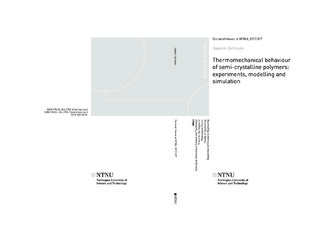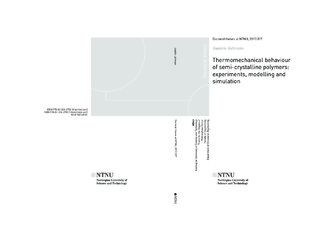| dc.contributor.advisor | Holm Clausen, Arild | |
| dc.contributor.author | Johnsen, Joakim | |
| dc.date.accessioned | 2018-01-10T07:58:45Z | |
| dc.date.available | 2018-01-10T07:58:45Z | |
| dc.date.issued | 2017 | |
| dc.identifier.isbn | 978-82-326-2703-5 | |
| dc.identifier.issn | 1503-8181 | |
| dc.identifier.uri | http://hdl.handle.net/11250/2476561 | |
| dc.description.abstract | This work presents experimental investigations on two semi-crystalline materials: a rubbermodified polypropylene (PP) and a cross-linked low density polyethylene (XLPE). Uniaxial tension and compression tests were performed at different temperatures and strain rates using a novel experimental set-up that involves optical measurements of the deformation. A thermomechanical constitutive model was developed, implemented and used to describe the mechanical behavior of the XLPE material. The thesis is organized as follows: A synopsis presents the background, motivation, objectives and scope along with a summary of the work, while the three journal articles in Parts 1 to 3 describe the scientific contributions in detail.
Part 1 presents the experimental set-up established to conduct tests at low temperatures. The experimental set-up consists of a transparent polycarbonate (PC) temperature chamber which, in contrast to conventional temperature chambers, allows the use of several digital cameras to monitor the test specimen during experiments. Consequently, local strain measurements could be performed by using for example digital image correlation (DIC). To facilitate instrumentation with an infrared thermal camera, a slit was added in the front window of the PC temperature chamber to obtain a free line-of-sight between the test specimen and the infrared camera. Utilizing this experimental set-up, a semi-crystalline XLPE under quasi-static tensile loading was successfully analysed using DIC at four different temperatures, T = 25 ◦C, T = 0 ◦C, T = −15 ◦C and T = −30◦C. At the lower temperatures, the conventional spray-paint speckle became brittle and cracked during deformation. An alternative method was developed using white grease with a black powder added for contrast. It was shown that neither the PC chamber nor replacing the conventional spray-paint speckle pattern with grease and black powder influenced the stress-strain curves as determined by DIC.
Part 2 presents uniaxial tension and compression experiments performed on both materials: the semi-crystalline rubber-modified polypropylene (PP) and the semi-crystalline cross-linked low density polyethylene (XLPE). The experimental set-up presented in Part 1 was used to perform uniaxial tension and compression tests at four different temperatures (T = 25 ◦C, T = 0 ◦C, T = −15 ◦C and T = −30 ◦C) and three initial nominal strain rates ( ˙ e = 0.01 s−1, ˙ e = 0.1 s−1 and˙ e = 1.0 s−1). DIC was used to obtain local stress-strain data from the tension experiments, while a combination of point tracking and edge tracing was used in the compression experiments. A scanning electron microscopy (SEM) study was performed to give a qualitative understanding of the substantial volumetric strain observed in the PP material and the small volumetric strains in the XLPE material. The mechanical behaviour of both materials was shown to be dependent on temperature and strain rate. More specifically, Young’s modulus increased for decreasing temperatures in both materials and for increasing strain rate in the XLPE material. The Ree-Eyring flow theory was used to successfully capture the temperature and strain rate dependent yield stress in both materials. In terms of volume change, the XLPE material was found to be nearly incompressible at room temperature, while it became slightly compressible at the lower temperatures. For the PP material the observed volumetric strains were substantial, ranging from approximately 0.5 to 0.9.
Part 3 presents the proposed thermoelastic-thermoviscoplastic constitutive model consisting of two parts: an intermolecular part described by an elastic Hencky spring coupled with two Ree-Eyring dashpots augmented with kinematic hardening from an inelastic Hencky spring, and an orientational part capturing entropic strain hardening due to alignment of the polymer chains using an eight chain spring. The objective of the study is to describe the effect of temperature and strain rate on the mechanical behaviour of the XLPE material investigated in Parts 1 and 2. The constitutive model was implemented in the commercial finite element (FE) program Abaqus/Standard as a UMAT subroutine. A numerical method was used to establish the consistent tangent operator together with a sub-stepping scheme to ensure convergence. The FE model yields accurate predictions of the stress-strain behaviour of the material, along with the volumetric strains, self-heating, strain rate and force vs. global displacement. | |
| dc.language.iso | eng | nb_NO |
| dc.publisher | NTNU | nb_NO |
| dc.relation.ispartofseries | Doctoral theses at NTNU;2017:317 | |
| dc.relation.haspart | Part 1:
Johnsen, Joakim; Grytten, Frode; Hopperstad, Odd Sture; Clausen, Arild Holm.
Experimental set-up for determination of the large-strain tensile behaviour of polymers at low temperatures. Polymer testing 2016 ;Volum 53. s. 305-313
https://doi.org/10.1016/j.polymertesting.2016.06.011 | |
| dc.relation.haspart | Part 2:
Johnsen, Joakim; Grytten, Frode; Hopperstad, Odd Sture; Clausen, Arild Holm.
Influence of strain rate and temperature on the mechanical behaviour of rubber-modified polypropylene and cross-linked polyethylene. Mechanics of materials 2017 ;Volum 114. s. 40-56
https://doi.org/10.1016/j.mechmat.2017.07.003 | |
| dc.relation.haspart | Part 3:
Johnsen, J., Clausen, A. H., Grytten, F., Benallal, A., and Hopperstad, O. S. (2017).
A thermoelastic-thermoviscoplastic constitutive model for semi-crystalline polymers. | |
| dc.title | Thermomechanical behaviour of semi-crystalline polymers: experiments, modelling and simulation | nb_NO |
| dc.type | Doctoral thesis | nb_NO |
| dc.subject.nsi | VDP::Technology: 500::Building technology: 530::Construction technology: 533 | nb_NO |
| dc.description.localcode | Digital fulltext not available | nb_NO |

